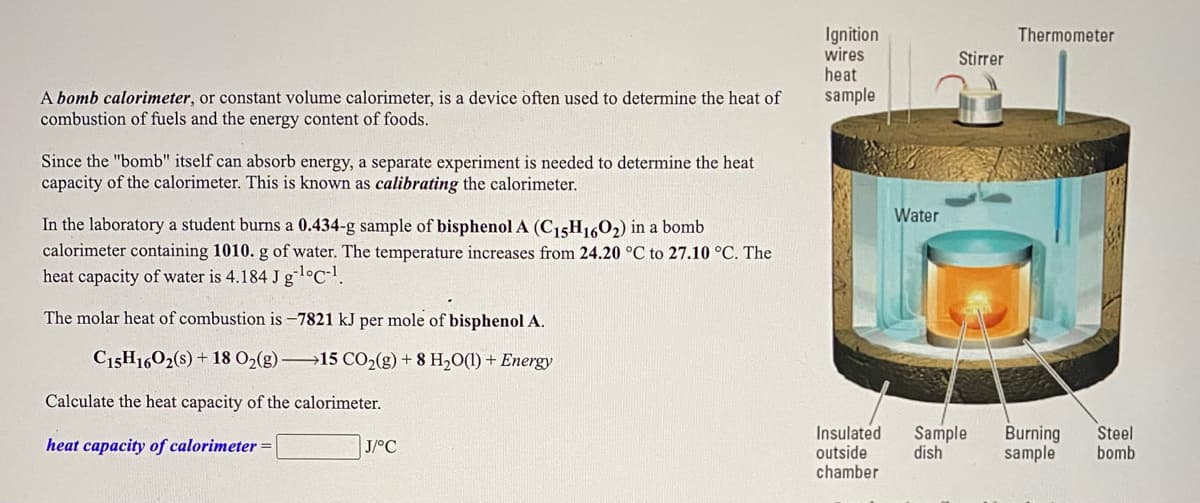Ignition wires heat sample Thermometer Stirrer A bomb calorimeter, or constant volume calorimeter, is a device often used to determine the heat of combustion of fuels and the energy content of foods. Since the "bomb" itself can absorb energy, a separate experiment is needed to determine the heat capacity of the calorimeter. This is known as calibrating the calorimeter. Water In the laboratory a student burns a 0.434-g sample of bisphenol A (C15H1602) in a bomb calorimeter containing 1010. g of water. The temperature increases from 24.20 °C to 27.10 °C. The heat capacity of water is 4.184 Jgl°C-l. The molar heat of combustion is -7821 kJ per mole of bisphenol A. C15H1602(s) + 18 02(g) →15 CO2(g) + 8 H,O(1) + Energy Calculate the heat capacity of the calorimeter. Insulated outside chamber Sample dish Burning sample Steel bomb heat capacity of calorimeter = J/°C
Ignition wires heat sample Thermometer Stirrer A bomb calorimeter, or constant volume calorimeter, is a device often used to determine the heat of combustion of fuels and the energy content of foods. Since the "bomb" itself can absorb energy, a separate experiment is needed to determine the heat capacity of the calorimeter. This is known as calibrating the calorimeter. Water In the laboratory a student burns a 0.434-g sample of bisphenol A (C15H1602) in a bomb calorimeter containing 1010. g of water. The temperature increases from 24.20 °C to 27.10 °C. The heat capacity of water is 4.184 Jgl°C-l. The molar heat of combustion is -7821 kJ per mole of bisphenol A. C15H1602(s) + 18 02(g) →15 CO2(g) + 8 H,O(1) + Energy Calculate the heat capacity of the calorimeter. Insulated outside chamber Sample dish Burning sample Steel bomb heat capacity of calorimeter = J/°C
Chemistry
10th Edition
ISBN:9781305957404
Author:Steven S. Zumdahl, Susan A. Zumdahl, Donald J. DeCoste
Publisher:Steven S. Zumdahl, Susan A. Zumdahl, Donald J. DeCoste
Chapter6: Thermochemistry
Section: Chapter Questions
Problem 112AE: In a bomb calorimeter, the reaction vessel is surrounded by water that must be added for each...
Related questions
Question
100%

Transcribed Image Text:Ignition
wires
heat
sample
Thermometer
Stirrer
A bomb calorimeter, or constant volume calorimeter, is a device often used to determine the heat of
combustion of fuels and the energy content of foods.
Since the "bomb" itself can absorb energy, a separate experiment is needed to determine the heat
capacity of the calorimeter. This is known as calibrating the calorimeter.
Water
In the laboratory a student burns a 0.434-g sample of bisphenol A (C15H1602) in a bomb
calorimeter containing 1010. g of water. The temperature increases from 24.20 °C to 27.10 °C. The
heat capacity of water is 4.184 J gl°C-l.
The molar heat of combustion is -7821 kJ per mole of bisphenol A.
C15H1602(s) + 18 02(g) →15 CO2(g) + 8 H,O(1) + Energy
Calculate the heat capacity of the calorimeter.
Insulated
outside
chamber
Sample
dish
Burning
sample
Steel
bomb
heat capacity of calorimeter =
J/°C
Expert Solution
This question has been solved!
Explore an expertly crafted, step-by-step solution for a thorough understanding of key concepts.
Step by step
Solved in 2 steps with 2 images

Knowledge Booster
Learn more about
Need a deep-dive on the concept behind this application? Look no further. Learn more about this topic, chemistry and related others by exploring similar questions and additional content below.Recommended textbooks for you

Chemistry
Chemistry
ISBN:
9781305957404
Author:
Steven S. Zumdahl, Susan A. Zumdahl, Donald J. DeCoste
Publisher:
Cengage Learning


Chemistry: An Atoms First Approach
Chemistry
ISBN:
9781305079243
Author:
Steven S. Zumdahl, Susan A. Zumdahl
Publisher:
Cengage Learning

Chemistry
Chemistry
ISBN:
9781305957404
Author:
Steven S. Zumdahl, Susan A. Zumdahl, Donald J. DeCoste
Publisher:
Cengage Learning


Chemistry: An Atoms First Approach
Chemistry
ISBN:
9781305079243
Author:
Steven S. Zumdahl, Susan A. Zumdahl
Publisher:
Cengage Learning

Chemistry: Principles and Reactions
Chemistry
ISBN:
9781305079373
Author:
William L. Masterton, Cecile N. Hurley
Publisher:
Cengage Learning

Principles of Modern Chemistry
Chemistry
ISBN:
9781305079113
Author:
David W. Oxtoby, H. Pat Gillis, Laurie J. Butler
Publisher:
Cengage Learning

Chemistry & Chemical Reactivity
Chemistry
ISBN:
9781337399074
Author:
John C. Kotz, Paul M. Treichel, John Townsend, David Treichel
Publisher:
Cengage Learning